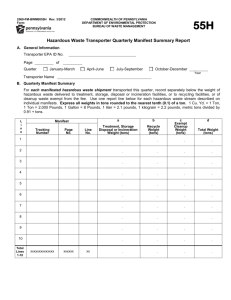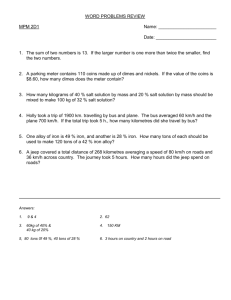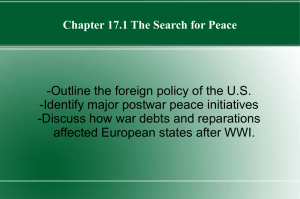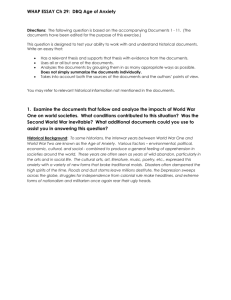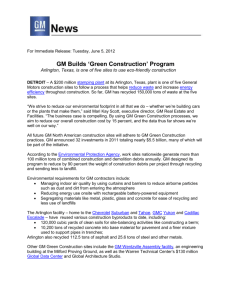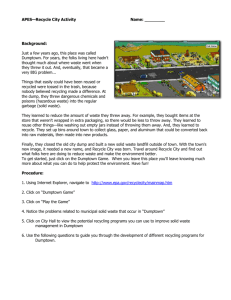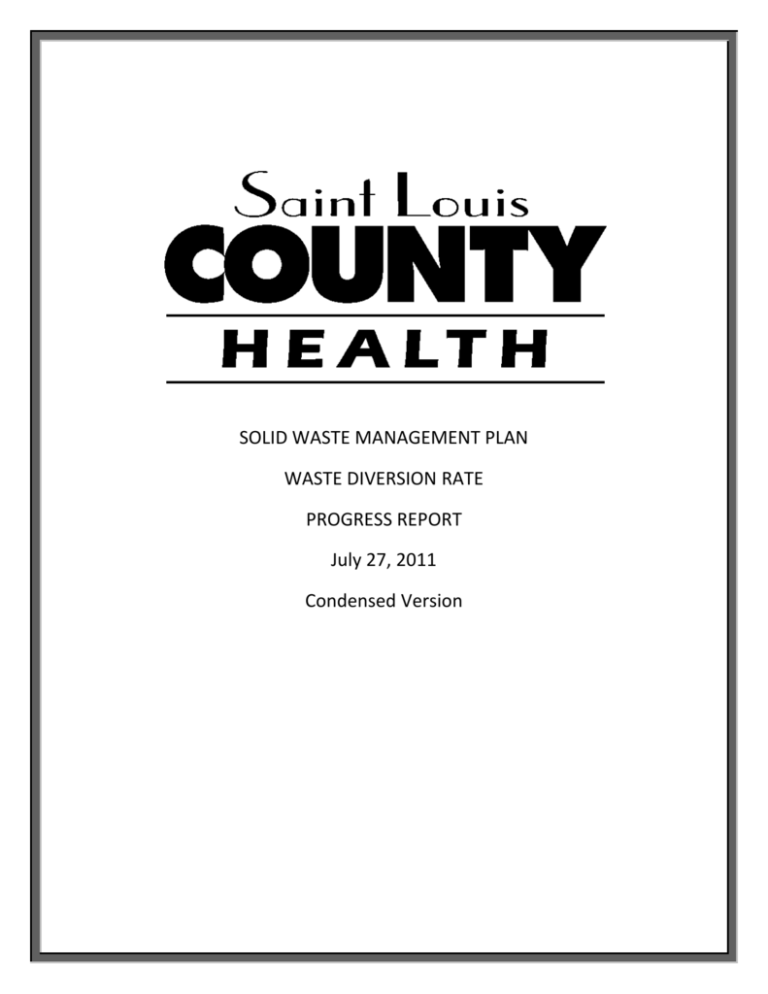
SOLID WASTE MANAGEMENT PLAN
WASTE DIVERSION RATE
PROGRESS REPORT
July 27, 2011
Condensed Version
Table of Contents
Section 1. Summation
1.1
Synopsis............................................................................................................... 1
Section 2. Introduction
2.1
2.2
2.3
Background ......................................................................................................... 2
General Information ........................................................................................... 2
Baseline Inventory 2003 ..................................................................................... 3
Section 3. Methodology
3.1
3.2
3.3
3.4
3.5
3.6
3.7
3.8
Methodology Explanation ................................................................................... 4
Tons Generated................................................................................................... 4
Tons Incinerated ................................................................................................. 5
Tons Banned........................................................................................................ 5
Tons Recycled...................................................................................................... 5
Tons Reduced ...................................................................................................... 5
Tons Landfilled .................................................................................................... 6
Table 1 (Waste Inventory & Waste Diversion Rate Calculation) ........................ 6
Appendices
Appendix DOH-1 - Methodology ......................................................................................
............................................................................ Waste Generation Adjustments
.................................................... Page 1-4, Table 1-2 from the R.W. Beck Report
....................................................... St. Louis County Population Data 2000-2010
.................................................... St. Louis County Employment Rates 2000-2010
.................................................... St. Louis County Taxable Sales Data 1992-2010
...................................... St. Louis County Consumer Price Index Data 1993-2010
.................................................... State of California Adjustment Method Factors
................................................Appendix A-4, Table 1 from the R.W. Beck Report
..................................................................... Page 1-3 from the R.W. Beck Report
Appendix DOH-2 – Banned Items .....................................................................................
......................................................................................................... Banned Items
............................................... Appendix A-3, Table 2 from the R. W. Beck Report
Table of Contents
Appendix DOH-3 – Yard Waste Banned Items .................................................................
......................................................................................Yard Waste Banned Items
..................................................................Yard Waste Banned Items Explanation
..... Yard Waste Facilities Annual License Renewals (not included in this version)
Appendix DOH-4 – Recycled Items ...................................................................................
....................................................................................................... Recycled Items
................................................................................... Recycled Items Explanation
.......... Recycling Centers Annual License Renewals (not included in this version)
............. Household Hazardous Waste (HHW) Data (not included in this version)
........... Special Waste Alternative Daily Cover Data (not included in this version)
Appendix DOH-5 – MDNR Waste Generation Rate .........................................................
............................................ Missouri Department of Natural Resources (MDNR)
2003 Waste Generation Rate
Summation
1.1 Synopsis
Infrastructure improvements, new regulations, economic incentives and better analysis have produced
a steady and significant improvement in the waste diversion rate calculated for 2007 through 2010. As
a result of these measures, the 2010 waste diversion rate for St. Louis County is 55.9%. The Health
Department’s diversion rate goal of 50% has been achieved and exceeded. Additional improvements
are possible and the Solid Waste Management Program will publish an update to the Solid Waste
Management Plan documenting the changes made that have increased the waste diversion rate and
propose a new diversion goal and the possible strategies for achieving it.
Introduction
2.1 Background
In 2004, Saint Louis County Department of Health (DOH) retained the services of R. W. Beck to develop
a 15-year master plan for solid waste management. The plan that was issued in May of 2005,
inventoried the existing solid waste management system, assessed its strengths and weaknesses and
identified strategies to optimize the performance of the system’s individual components. The plan was
designed to provide County residents, businesses and government officials with an understanding of
County solid waste management issues and concerns.
The inventory of the solid waste management system demonstrated that in 2003, the waste diversion
rate (WDR) for the County was about 30%. The conclusion of the study was that without changing
certain aspects of the plan, the WDR would stay the same to the year 2015. The DOH, after analyzing
the recommendations of the report, established six goals and pursued several strategies to increase
the WDR to 50% by the year 2010.
To assess DOH’s progress toward meeting the 50% goal, it was necessary to update the waste
inventory from the 2003 results obtained by R. W. Beck. This report provides updates for the waste
inventories and the resulting WDR’s for the years 2007 through 2010.
2.2 General Information
This inventory update utilized the basic methodology and information presented in the 2003 results
from R. W. Beck and updated to the years stated. As new or better information became available to
the DOH, that information was used with appropriate documentation. DOH staff used national, state,
and local information, information reported to the County by regional facilities and operators, as well
as local knowledge of the metropolitan area and the waste management system to perform this
update.
Introduction
2.3 Baseline inventory 2003
The 2003 inventory calculated the WDR with the following formula:
WDR = Tons diverted / tons generated
(tons diverted is the sum of tons incinerated, tons banned, tons recycled and tons reduced)
The waste inventory used the following formula:
Tons generated = tons landfilled + tons incinerated + tons banned + tons recycled + tons source reduced
The numbers generated by R. W Beck for the 2003 inventory (see Appendix DOH-1 and Table 1) were:
Tons generated (WG) = 1,904,671
Tons incinerated = 0
Tons banned = 198,714
Tons recycled = 278,900
Tons reduced = 95,234
Tons landfilled = 1,331,823 (calculated from above figures)
WDR = 30.1%
Population = 1,013,123
Methodology
3.1 Methodology Explanation
The methodology used to prepare this report utilized the same formulas and categories as the Beck
study to update and improve the information for 2007 through 2010. Recent updates to US Census
population reports for years 2003 through 2010 resulted in updated baseline and projected years
calculations. In addition, a correction was made to the baseline tons generated figure due to an error
in the Beck study. Also, economic factors were used to provide tons generated figures for 2007
through 2010.
3.2 Tons generated
The solid waste generation rate was based on a per capita generation rate provided by the Missouri
Department of Natural Resources (MDNR) multiplied by the population to estimate a total annual
generation. RW Beck used 10.32 pounds per capita per day which included both residential and
industrial/commercial/institutional (ICI) sectors and a population of 1,013,123 (U.S. Census Bureau).
However, this generation rate was for the year 2001, not 2003 as stated in the R. W. Beck study (see
Appendix DOH-1). Also U.S. Census Bureau population figures have changed for the base and
succeeding years. MDNR reported that the 2003 per capita waste generation rate was 10.83 pounds
per capita per day (see Appendix DOH-5).
Therefore the Solid Waste Management Program updated the baseline R. W. Beck numbers for 2003
and then made the projections for 2007 through 2010. Research from the State of California provided
a methodology to estimate waste generation rates based upon several economic factors such as
unemployment, the Consumer Price Index, and gross sales tax receipts. The calculations are found in
Appendix DOH-1 and the results are as follows:
WG (pounds per person per day)
Updated population estimates
Population
2003
10.83
2007
10.74
2003
1,008,956
2007
993,690
2008
10.31
2008
992,331
2009
9.85
2010
9.91
2009
992,408
2010
998,954
Recalculated tons generated for the years 2003, and 2007 through 2010 are presented in 3.8 Table 1,
Waste Inventory and Waste Diversion Rate Calculation.
Methodology
3.3 Tons Incinerated
The St. Louis metropolitan area does not have any waste-to-energy facilities that incinerate waste so
the total tons incinerated continues to be 0 for each year.
3.4 Tons Banned
The State of Missouri has banned from landfill disposal the following items that are included in the
waste generation rate: Major appliances, lead-acid batteries, tires, waste oil, and yard waste. These
materials are recovered for beneficial reuse or recycling. The R. W. Beck study used per capita
generation rates to estimate tons generated for the baseline year of 2003 (see Appendix DOH-2). The
inventory update used these same factors with a correction for economic factors from the California
study. Results are listed in Appendix DOH-2 for major appliances, lead-acid batteries, tires, and waste
oil.
St. Louis County has licensed several composting facilities where yard waste and other organics can be
properly disposed. Yard waste tonnages come from volume reports submitted to the County through
these facilities annual license renewal. Results are given in Appendix DOH-3.
Total tons banned is the sum of the values from Appendices DOH-2 and DOH-3 and is given in 3.8 Table
1.
3.5 Tons Recycled
The Solid Waste Management Program made an aggressive attempt to quantify tons of material
recycled throughout the metropolitan area that was generated in St. Louis County. The R. W. Beck
report identified 7 different facilities in their report and estimated a quantity of 278,900 tons of
material recycled. This update has identified over 18 additional facilities and several more sources of
diverted volumes, such as materials recovered from household hazardous waste collection, special
waste used as alternative daily cover on landfills, etc. Total tonnage is given in 3.8 Table 1 and
Appendix DOH-4
3.6 Tons Reduced
The R. W. Beck report included a 5% tons reduced at source in the baseline 2003 calculation. This same
credit was taken for 2007 through 2010, however each year’s numbers were updated for 2003 through
2010 based upon the new tons generated figures provided in this update. Results are in 3.8 Table 1.
Methodology
3.7 Tons Landfilled
This number is calculated by subtracting tons incinerated, tons banned, tons recycled and tons reduced
from tons generated. Results are in 3.8 Table 1. (Note: this number is calculated by the above
method)
3.8 Table 1
WASTE INVENTORY & WASTE DIVERSION RATE CALCULATION
Year
Waste Generation Rate
(WGR)
2003
2007
2008
2009
2010
10.83
10.74
10.31
9.85
9.91
Population
1,008,956
993,690
992,331
992,408
998,954
Tons generated (WG)
Tons incinerated
Tons banned
Tons Recycled
Tons reduced at source
Total tons diverted
1,994,176
0
198,714
278,900
99,709
577,323
1,948,016
0
260,409
530,274
97,401
888,084
1,867,856
0
228,021
622,507
93,393
943,920
1,783,101
0
214,032
558,794
89,155
861,981
1,807,320
0
265,106
654,360
90,366
1,009,832
Tons landfilled
1,416,853
1,059,932
45.6%
923,935
50.5%
921,120
48.3%
797,488
55.9%
Waste Diversion Rate (WDR)
29.0%
Appendix DOH-1
Appendix DOH-1
Waste Generation Adjustments
2003
1,008,956
516,148
0
2007
993,690
502,704
0
2008
992,331
490,271
0
2009
992,408
470,073
0
2010
998,954
465,387
Population
Employment (St. Louis County)
United States
St.Louis/IL Metro
Taxable Sales Receipts (TSR)
14,044,112,162 15,465,677,181 14,934,910,920 13,913,036,879 14,728,983,170
Consumer Price index
184
207
215
215
218
Residential waste generated (tons)
*
538,428
527,786
514,969
501,759
507,013
Commercial waste generated (tons)
*
1,455,749
1,420,230
1,352,887
1,281,342
1,300,308
Total Waste Generated
1,994,176
1,948,016
1,867,856
1,783,101
1,807,320
* total waste generation is divided into 27% residential and 73% commercial (See Page 2 of this Appendix)
Commercial Adjustment Factor (CAF) =
0.975601055
0.929340708
0.880194619
0.893222525
Residential Adjustment Factor (RAF) =
0.980235282
0.95643164
0.931896754
0.941654654
Adjusted Waste Generation (current year) =
residential adjusted
commercial adjusted
Economic adjustment factor
Adjusted Waste Generation Rate (current year) =
1948016
527786
1420230
0.976852296
10.74
1867856
514969
1352887
0.93665526
10.31
1783101
501759
1281342
0.894154195
9.85
1807320
507013
1300308
0.9062992
9.91
Solid Waste Management Plan Waste Diversion Rate Progress Report
Page 1 of 10
07/27/2011
Appendix DOH-1
Section 1
The per household (HH) disposal rate, using results from R. W. Beck’s 2004
municipal surveys, was estimated to be 36.77 pounds/HH/week or 14.9
pounds/capita/week.
The HH recycling rate, using results from R. W. Beck’s 2004 municipal surveys
and the St. Louis-Jefferson Solid Waste Management District’s 2003 Waste
Assessment Inventory, was estimated to be 4.2 pounds/HH/week or 1.7
pounds/capita/week.
The amount of banned items collected was calculated to be 7.5 pounds/HH/week
or 3.0 pounds/capita/week using estimated quantities of items banned from
disposal.
The sum of these components equals 48.47 pounds/HH/week or 19.6
pounds/capita/week of residential solid waste generated. The U.S. Census Bureau
estimate of 2.47 persons per household was used as a basis for converting per
household generation rates to per capita generation rates. The ICI total was calculated
by subtracting the residential tons from the total waste stream, as shown below in
Table 1-2.
Table 1-2
Saint Louis County
Solid Waste Generation by Sector
2003 Estimated
Generation
(Tons)
Percentage of Total
Waste Stream
516,280
27%
ICI
1,388,390
73%
Total Waste Stream
1,904,670
100%
Generator Sector
Residential
Per R. W. Beck’s experience, these residential and ICI percentages are similar to other
regions with a similar non-residential generator base.
1.2.1.1 Tons Landfilled
In May of 2004, R. W. Beck sent surveys to facilities that were likely to dispose of or
process the County’s solid waste including landfills, transfer stations, recycling
centers, compost facilities, and demolition landfills (see Section 2.1 of this report for
survey details).
In 2001, the state-wide per capita disposal rate was estimated at 1.11 tons per person
per year or 6.08 pounds per capita per day by the MDNR. This was estimated by
dividing the total tons of solid waste disposed by Missouri (6,222,402) by the 2001
1-4 R. W. Beck
Solid Waste Management Plan Waste Diversion Rate Progress Report
B1545
Page 2 of 10
07/27/2011
Appendix DOH-1
Employment Rates
St. Louis County & St. Louis Region
2000 - 2010
Year
County
Region
2000
540,778
1,373,227
2001
534,906
1,367,082
2002
527,220
1,357,248
2003
516,148
1,342,568
2004
507,758
1,339,495
2005
508,645
1,356,121
2006
507,486
1,373,986
2007
502,704
1,376,342
2008
490,271
1,355,142
2009
470,073
1,298,123
2010
465,387
1,293,535
Region data include metro area including IL
Source: Missouri Economic Research and Information Center
(http://www.missourieconomy.org/indicators/laus/Default.aspx)
Solid Waste Management Plan Waste Diversion Rate Progress Report
Page 3 of 10
07/27/2011
Appendix DOH-1
Employment Rates
St. Louis County & St. Louis Region
2000 - 2010
Year
County
Region
2000
540,778
1,373,227
2001
534,906
1,367,082
2002
527,220
1,357,248
2003
516,148
1,342,568
2004
507,758
1,339,495
2005
508,645
1,356,121
2006
507,486
1,373,986
2007
502,704
1,376,342
2008
490,271
1,355,142
2009
468,888
1,297,935
2010
465,387
1,293,535
Region data include metro area including IL
Source: Missouri Economic Research and Information Center
(http://www.missourieconomy.org/indicators/laus/Default.aspx)
Solid Waste Management Plan Waste Diversion Rate Progress Report
Page 4 of 10
07/27/2011
Appendix DOH-1
St. Louis County
Taxable Sales Data
1992 - 2010
Year
Sale Tax Only
Sales & Use Tax
2010
$
13,965,882,115 $
14,728,983,171
2009
$
13,913,036,898 $
14,661,548,156
2008
$
14,934,910,920 $
15,805,665,932
2007
$
15,465,677,181 $
16,441,143,612
2006
$
15,325,527,426 $
16,235,419,000
2005
$
15,028,847,484 $
15,841,609,382
2004
$
14,494,446,666 $
15,280,209,006
2003
$
14,044,112,162 $
14,708,757,672
2002
$
13,986,990,722 $
14,675,108,758
2001
$
13,920,597,496 $
14,683,202,033
2000
$
13,771,443,747 $
14,527,680,858
1999
$
13,374,973,331 $
14,193,561,689
1998
$
12,760,004,429 $
13,565,255,671
1997
$
12,483,623,322 $
13,141,120,725
1996
$
12,131,457,451 $
12,841,920,153
1995
$
11,768,506,349 $
12,545,556,030
1994
$
11,400,444,350 $
11,699,462,185
1993
$
10,487,180,827 $
10,509,744,414
1992
$
10,032,100,058 $
10,048,233,036
Source:
Missouri State Department of Revenue
Solid Waste Management Plan Waste Diversion Rate Progress Report
Page 5 of 10
07/27/2011
Appendix DOH-1
St. Louis County
Consumer Price Index Data
1993 - 2010
Year
CPI
1993
1994
1995
1996
1997
1998
1999
2000
2001
144.500
148.200
152.400
156.900
160.500
163.000
166.600
172.200
177.100
CPI Difference from
Last Year
-0.7%
2.5%
2.8%
2.9%
2.2%
1.5%
2.2%
3.3%
2.8%
2002
179.900
1.6%
2003
184.000
2.2%
2004
188.900
2.6%
2005
195.300
3.3%
2006
201.600
3.1%
2007
207.342
2.8%
2008
215.303
3.7%
2009
214.537
-0.4%
2010
218.100
1.6%
Description:
CPI-U, all items 1982-84=100, not seasonally adjusted
Source:
*U.S. Department of Labor, Bureau of Labor Statistics
**Missouri Economic Research and Information Center
(http://www.missourieconomy.org/indicators/Cpi/Default.aspx)
Solid Waste Management Plan Waste Diversion Rate Progress Report
Page 6 of 10
07/27/2011
Adjustment Method Factors
Appendix DOH-1
Page 1 0[2
http://www.calrecycle.ca.gov/LGCentral/DivMeasure/AdjustMethod/AdjMetFc.htm
CalReCYCle~
Local Government Central
i\djustl11clltl\'Icthod Factors
Note: This page contains historical information from CIWMB's statewide goal measurement prior to 2007 that estimated a
diversion percentage. For 2007 and subsequent years, CIWMB compares reported disposal tons to population to calculate per
capita disposal expressed in pounds/person/day. This new goal measurement system is described in CIWMB's Goal
Measurement: 2007 and Later web page.
» What is the Adjustment Method?
) Population
s Employment
.» Taxable Sales
» Consumer Price Index
» Adjustment Method
and Taxable Sales Deflator
Formula
What is the Adjustment Method?
The "adjustment method" is a formula for annually estimating jurisdiction solid waste tons generated. Chapter 1292, Statutes of 1992
(Sher, AS 2494) required the Board to develop a standard methodology so that jurisdictions would have a cost-effective way to estimate
how much waste they generate (see Public Resources Code 41780.1). Title 14, California Code of Regulations (14 CCR), Chapter 9,
Article 9.1 requires that population, employment, taxable sales, and Consumer Price Index be used in the adjustment method formula.
For more information about the adjustment method, see Adjustment Method Questions and Answers, or Board-Approved Adjustment
Method and Goal Measurement.
Population
Population is used in the adjustment method because it strongly influences residential waste generation. Every ten years the U.S. Census
Bureau counts the number of people living in each California city and county. The most recent census count was done in 2000. The
California Department of Finance (DO F) estimates city and county January 1st population for the years between Census counts, e.g.,
1991-1999 and 2001-2009. The Board's Electronic Annual Report (EAR) uses population data from DOF's E-4 Population Estimates for
Cities Counties and the State 2001-2005 with 2000 ORU Benchmark, released in May each year. For 1990-1999 population data, see
Revised Historical City County and State Population Estimates 1991-2000. with 1990 and 2000 Census Counts. Jurisdictions may use
either jurisdiction- or county-level population when estimating waste generation tons, then a diversion rate.
Employment
Employment strongly influences both residential and nonresidential waste generation. There are two distinct types of employment data.
Labor force employment, also known as civilian employment, is the number of people living in a geographic area that have at least one
job. Industrv employment is the number of jobs in a geographic area. The California Employment Development Department (EDD)
estimates both labor force and industry employment for each California county. Jurisdictions may use either county-level labor force or
industry employment when estimating waste generation tons, then a diversion rate.
Taxable Sales
Taxable Sales strongly influences both residential and nonresidential waste generation. Taxable sales is the dollar amount of all
transactions subject to California Sales and Use Tax. The State Board of Equalization (BOE) reports quarterly and annual taxable sales
for each California city and county. Jurisdictions may use either jurisdiction- or county-level taxable sales when estimating waste
generation tons, then a diversion rate.
Consumer Price Index and Taxable Sales Deflator
The Consumer Price Index (CPI) is a measure of inflation experienced by consumers and is an important indicator of the condition of the
economy. CPI is used in the adjustment method to adjust taxable sales for inflation. The U.S. Department of Labor Bureau of Labor
Statistics (BLS), releases CPI for three metropolitan areas in California: (1) San Francisco/Oakland/San Jose, (2) Los
Angeles/Anaheim/Riverside, and (3) San Diego. Subsequently, the California Department of Industrial Relations (DIR) uses a weighted
average of the San Francisco/Oakland/San Jose and Los Angeles/Anaheim/Riverside metropolitan CPls to compute a California
Statewide CPl. All of this CPI data is available on the DIR website. Jurisdictions may use either their metropolitan area (where applicable)
or statewide CPI when estimating waste generation tons, then a diversion rate.
Board research in 2004 indicates that BOE's Taxable Sales Deflator (TSD) is a more accurate measure of inflation for taxable sales. TSD
is a measure of inflation only for items subject to California Sales and Use Tax. CPI measures inflation of all consumer goods and
services, regardless of whether they are subject to California Sales and Use Tax. For a more detailed discussion of the differences
between TSD and CPI, see BGE's February 2004 issue of Economic Perspective (Adobe PDF, 654 KB). TSD is only available at the
statewide level. In September 2005, the Board directed staff to allow jurisdictions to use the Board's Taxable Sales Deflator Index (TSDI)
as an acceptable alternative to CPI for diversion rate calculations.
Solid Waste Management Plan Waste Diversion Rate Progress Report Page 7 of 10
http://www.calrecycle.ca.gov/LGCentral/DivMeasure/AdjustMethodlAdjMetFc.htm
07/27/2011
10/28/2010
Page 2 of2
Adjustment Method Factors
Appendix DOH-1
http://www.calrecycle.ca.gov/LGCentral/DivMeasure/AdjustMethod/AdjMetFc.htm
Adjustment Method Formula
Note: Step-by-step instructions and automated calculations are available in the Model Annual Report. Also available is a step-by-step written description of the
adjustment method formula.
Formula:
[Estimated Reporting Year Generation] :::
[Base Year Residential Waste Generation Tons] x [Residential Adjustment Factor] +
[Base Year Nonresidential Waste Generation Tons] x [Nonresidential Adjustment Factor]
[Residential Adjustment Factor] = [(PRlPB) + {ERIEB + (CB/CR x TRffB)}/2]/2
[Nonresidential Adjustment Factor] = [ERIEB + (CB/CR x TRffB)I/2
Adjustment Factors:
PR::: Reporting Year Population
ER::: Reporting Year Employment
PB ::: Base Year Population
EB ::: Base Year Employment
CR::: Reporting Year Consumer Price Index CB::: Base Year Consumer Price Index
TB Base Year Taxable Sales
TR Reporting Year Taxable Sales
=
=
Diversion Rate Measurement Home I Basics: Adiustment Factors I Jurisdiction Default Adjustment Factors
last updated: September 16, 2009
local Government Central http://www.calrecycleca.qovllGCentralf
larry N. Stephens: Larrv,Stephens@calrecycle,ca,gov(916)341-6241
Conditions of Use I Privacy Policy
©1995 2010 California Department of Resources Recycling and Recovery (CaIRecycle). All rights reserved.
Solid Waste Management Plan Waste Diversion Rate Progress Report Page 8 of 10
http://www.calrecycle.ca.gov/LGCentral/DivMeasure/AdjustMethod/AdjMetFc.htm
07/27/2011
1012812010
Appendix DOH-1
2004 DIVERSION RATE MEASUREMENT MODEL
Table 1
Saint Louis County Solid Waste
Generation and Diversion
Calendar Year 2003
Calendar Year 2015
1,013,123
1,020,9001
95,234
95,967
1,904,671 Tons
1,919,337 Tons
278,900 Tons
281,048 Tons
Residential
44,932
45,278
ICI
233,968
235,770
198,714 Tons
200,244 Tons
Appliances
7,598
7,657
Lead-Acid Batteries
6,687
6,738
Tires
10,131
10,209
Waste Oil
16,210
16,335
Yard Waste
158,088
159,305
1,331,823 Tons
1,342,078 Tons
30.1%
30.1%
Population
Source Reduction Allowance
Solid Waste Generation
Recyclable Materials
Banned Recycled Materials
Total Solid Waste Landfilled
% Diversion
1
Source: East-West Gateway Council of Governments, based on 2000 U.S. Census Bureau population data.
4.3 Key Findings/Recommendations
R. W. Beck conducted an analysis that documents a calendar year 2003 diversion rate
of approximately 30.1 percent. Although the documented diversion rate does not meet
the State's 40 percent reduction goal in the quantity of solid waste landfilled, the
absence of formalized reporting procedures for components of the County's solid
waste management system may result in underestimating the total quantity of solid
waste diverted. Moreover, some large commercial businesses and industry are likely
to be diverting additional materials without utilizing the County's existing collection,
processing and disposal system, but through hauling and recovery arrangements
external to the system.
The following implementation considerations are recommended to enhance the data
collection process in the future and update the Model, as necessary, for the 12-year
planning period, 2003-2015:
Work with the Missouri Department of Natural Resources to establish a set of
source reduction program criteria to quantify source reduction activities;
Continue to implement a new Environmental Public Health Information System
(EPHIS) as recommended in the February 2004, County Auditor’s report
(Attachment ___ [to be included in final draft]). This system should consist of
R. W. Beck 4-3
B1545
Solid Waste Management Plan Waste Diversion Rate Progress Report
Page 9 of 10
07/27/2011
Appendix DOH-1
DESCRIPTION OF WASTE
Based on the most current (2001) data from the MDNR11, the state-wide solid waste
generation rate is estimated at 10.32 pounds per capita per day (PCD) or 1.88 tons per
capita per year. This per capita estimate incorporates generation for both the
residential and industrial/commercial/institutional (ICI) sectors. Based on data from
the U.S. Census Bureau, the population estimate for Saint Louis County in 2003 was
1,013,123 which equates to an estimate of 1,904,671 tons of solid waste generated in
Saint Louis County in 2003.
The total quantity of solid waste generated in the County is the sum of the quantities
of solid waste landfilled, incinerated, banned from landfill disposal, recycled, and tons
reduced at the source.
Tons
Generated
=
Tons
Landfilled
+
Tons
Incinerated
+
Tons
Banned
from
Disposal
+
Tons
Recycled
+
Tons
Reduced
at Source
Solid waste management planning involves utilizing available data and information
concerning the existing system along with previous planning experience to develop
reasonable estimates for the planning area. The following sources of information were
used to estimate the total quantities of solid waste generated in Saint Louis County:
Disposal information reported to the MDNR and the Illinois Environmental
Protection Agency (IL EPA) from landfills in the region;
Survey data gathered by R. W. Beck from waste haulers, municipalities, and solid
waste facilities;
Past studies specific to Missouri and the region (i.e., the MDNR’s Missouri Solid
Waste Diversion and Recycling Status Reports; the Midwest Assistance
Program’s 1999 Missouri Solid Waste Composition Study; R. W. Beck’s 2004
Diversion Rate Measurement Model; and the St. Louis-Jefferson Solid Waste
Management District’s 2003 Waste Assessment Inventory);
National MSW per capita generation estimates; and
R. W. Beck waste generation, recycling, and composition database.
Dividing the solid waste stream into various components provides an opportunity to
more accurately quantify and characterize the waste stream by generator type. In
other words, individual sectors with different types of waste generators can be
identified and focused upon for program implementation/improvement.
R. W. Beck estimated the quantity of residential solid waste generated in the County
by estimating the sum of the amount of refuse disposed, the amount of recyclable
materials, and estimated quantities of banned items diverted from disposal. We
developed the following as a basis for the calculation:
11
Source: “Missouri Solid Waste Diversion and Recycling Status Report for Calendar Year – 2001”,
MDNR.
R. W. Beck 1-3
B1545
Solid Waste Management Plan Waste Diversion Rate Progress Report
Page 10 of 10
07/27/2011
Appendix DOH-2
Appendix DOH-2
BANNED ITEMS
Year
Population
Economic factor*
2003
1,008,956
2007
993,690
0.976852296
2008
992,331
0.93665526
2009
992,408
0.894154195
2010
998,954
0.9062992
Total banned (tons)
appliances
lead-acid batteries
tires
waste oil
Yard Waste**
198,714
260,409
228,021
214,032
265,106
7,598
6,687
10,131
16,210
158,088
7,280
6,407
9,707
14,560
222,456
6,971
6,135
9,295
13,942
191,678
6,655
5,857
8,874
13,310
179,336
6,790
5,975
9,054
13,580
229,707
*From Appendix DOH-1
**From Appendix DOH-3
Solid Waste Management Plan Waste Diversion Rate Progress Report
Page 1 of 2
07/27/2011
Appendix DOH-2
Appendix A-3
Table 2
Banned Materials Generation
Banned Material
Appliances 1
Lead-Acid Batteries
Estimated Generation per Capita
Total Tons
Generated
15 pounds/capita/year
7,598
13.2 pounds/capita/year
6,687
3
20 pounds/capita/year
10,131
Waste Oil 4
32 pounds/capita/year
16,210
8.3% of total solid waste generated
158,088
Tires
2
Yard Waste 5
Total
1
2
3
4
5
198,714
Assumes each appliance weighs an average of 150 pounds (OEA).
Assumes one lead-acid battery weighs 40 pounds (OEA).
Assumes each tire weighs an average of 20 pounds (OEA).
Assumes 8 pounds per gallon (OEA).
Assumes one cubic yard of yard waste equals 300 pounds and yard waste generation is 8.3 percent of the 1,904,671 total solid waste
tons generated in Saint Louis County during calendar year 2003.
3.1.2 Source Reduction Allowance
The State of Missouri has identified source reduction (reducing the amount of solid
waste generated) as the first component of its solid waste management hierarchy.
Like other states across the Country, the source reduction component of an integrated
solid waste management system relies heavily on the success of a well-defined public
education program.
The Waste Management Branch has developed a "Reduce, Reuse, Recycle...
Naturally!" public education campaign. This public education program incorporates
the three "R's" of solid waste management. Based upon the program components of
"Reduce, Reuse, Recycle... Naturally!" and review of recycling education program
criteria of other states across the Country (i.e., California and Minnesota), a maximum
5 percent source reduction allowance (95,234 tons for calendar year 2003) is included
in the Diversion Rate Measurement Model.
3.1.3 Recycling
Twenty-four (24) municipalities responded to a written survey in 2004. Based on the
survey results, approximately 17,579 tons of residential recyclable material was
collected in 2003. Based on these reported figures, an overall recycling rate of 93.0
pounds per capita per year was calculated.
Table 3 summarizes results of the Municipal Solid Waste Survey.
3-6 R. W. Beck
Solid Waste Management Plan Waste Diversion Rate Progress Report
B1545
Page 2 of 2
07/27/2011
Appendix DOH-3
Appendix DOH-3
BANNED ITEMS (Yard Waste)
Year
2003
Yard Waste
158088
Earth City Supply*
Ellisville*
Fick Supply Inc*
Fred Weber
Ladue
Mo-Pass
ORMI
Rt. 66
St. Louis Composting
Others
*new facilities since the 2009 report
2007
222,456
Solid Waste Management Plan Waste Diversion Rate Progress Report
30,648
18,812
62,864
33,330
1,010
75,792
Page 1 of 2
2008
191,678
25,360
9,803
73,749
14,520
1,826
66,420
2009
179,336
21,840
8,833
55,409
19,965
2,298
70,991
2010
229,707
4,072
2,700
37,627
25,749
15,254
52,241
16,500
7,274
68,290
07/27/2011
Appendix DOH-3
Tons Banned Yardwaste
According to Chapter 607 Solid Waste Management Code (the Waste Code), licensed yardwaste
compost facilities are required to annually renew their operating license. As part of the license
renewal application, the facilities must report quantities of yardwaste received and
compost/mulch produced for the previous 12-month period. The annual license renewal date
varies so licensed facilities do have different 12-month reporting timeframes (e.g., Apr 1-Mar
30, July 1-June 30, etc.). The total tonnage of yardwaste from the annual license renewal
applications is provided in this report.
Assumptions:
Treated the 12-month reporting timeframe as the actual calendar year.
Conversion rate = 0.33 cubic yards/ton
Solid Waste Management Plan Waste Diversion Rate Progress Report
Page 2 of 2
07/27/2011
Appendix DOH-4
Appendix DOH-4
RECYCLED ITEMS
Year
Total recycled (tons)
Licensed Recycling Centers
Appliances Inc*
Branch Metal Processing
Central Paper Stock
Cintas
City of Kirkwood/Francis
Scheidegger Recycling Depository
Computer Trade*
DCAL
Earthbound Recycling
Ecorecycling
EPC
Imperial Paper Stock
Metal Recovery Systems
Midwest Recycling Center*
Nationwide Recycling
Overland Metals
Republic Services Recycling**
Resource Management
Shred & Protect Document*
University City drop off***
Wallach Iron and Metal
Total
Other Recovery Operations
Gunther
Meramec Valley WPF*
Parkway Recycling Center***
Remains Inc.
Smurfit
Strategic Materials (glass)*
U'S Again
WITS*
Total
HHW
Special Waste ADC
GRAND TOTAL (tons)
2007
2008
2009
2010
0
10,000
23,483
9,000
0
9,000
22,723
9,000
0
10,438
16,675
9,000
25,000
11,380
19,225
9,200
3,831
0
908
0
101,000
2,005
3,106
21,007
0
208
1,500
120,599
46,881
0
49
22,100
365,678
3,476
0
2,402
0
145,035
2,600
3,011
20,116
0
208
1,500
140,368
71,735
0
62
22,100
453,336
2,679
0
1,371
273
149,925
2,171
2,079
12,685
0
120
1,500
137,903
81,329
0
0
25,629
453,777
2,510
250
2,057
415
179,009
1,245
10,783
16,781
2,500
240
1,500
141,461
90,332
120
0
24,620
538,628
350
0
70
609
107,864
10,492
480
180
119,695
549
47,833
533,755
350
0
93
662
117,421
16,361
403
313
135,252
520
36,525
625,633
340
0
127
633
75,090
15,507
437
576
92,370
646
14,340
561,133
360
2,518
0
474
78,055
16,481
812
1,277
99,977
754
15,000
654,359
*new facilities/data added since 2009 report
**facility name & ownership change, formerly QRS Recycling (effective Dec 2010), includes data from Northside & Southside
***since 2009 report, facilities now send material to another facility on this list
Solid Waste Management Plan Waste Diversion Rate Progress Report
Page 1 of 2
07/27/2011
Appendix DOH-4
Tons Recycled
Recycling Centers
As defined by the Waste Code, the Solid Waste Program licenses facilities located in St. Louis
County that accept source-separated materials for shipment to end-markets as “recycling
centers”. These licensed facilities are required to report the annual quantities of materials
collected and shipped for the previous calendar year as part of the annual license renewal
application. This data is provided in this report.
Licensed Solid Waste Facilities
Currently, some licensed waste processing facilities sort and recover materials for recycling. All
licensed solid waste facilities are required to report quantities of recovered materials for the
previous 12-months as part of the annual license renewal application. As with yardwaste
compost facilities, the annual license renewal dates and 12-month reporting timeframes do
vary. So, for the purpose of this report, the recyclable quantities on the annual license renewal
application are reported for the previous calendar year.
Household Hazardous Waste (HHW)
The total quantity of collected materials from the St. Louis County Household Chemical
Collection Program is reported by the licensed hazardous waste management contractor. This
data is provided as part of the invoice payment process.
Special Waste Alternative Daily Cover (ADC)
Daily cover, as well as intermediate and final cover, is not included in available airspace
calculations for licensed landfills. Certain types of special waste can be approved for use as
daily cover as an alternative to clay soils. Fred Weber Sanitary Landfill and Veolia Oakridge
Landfill provided the annual tonnage for 2007 through 2009. The email correspondence is
attached. Since publishing the 2009 progress report, Fred Weber Sanitary Landfill was
purchased by IESI (Progressive Waste Solutions). Due to IESI corporate policies, we accepted a
verbal estimate for Year 2010.
Solid Waste Management Plan Waste Diversion Rate Progress Report
Page 2 of 2
07/27/2011
Appendix DOH-5
Appendix DOH-5
Missouri Department of Natural Resources
Daily Per Capita Generation/Diversion/Disposal
14
12
10
10.08
10.83
10.56
10.32
11.14
11.73
11.45
Pounds
8
6
6.24
6
6.3
5.98
6.15
6.06
6.64
6.45
6
5.88
5.26
4
6.19
5.26
5.15
4.83
4.58
4.27
6.99
6.58
6.83
3.84
2
0
2000
2001
2002
2003
2004
2005
2006
Year
Diversion
MSW Generation
Disposal
All Generation
Table 2
State
Arkansas
Illinois
Iowa
Kansas
Kentucky
Missouri
Nebraska
Oklahoma
Tennessee
Calendar Year
2004
Population
2,752,629
12,713,634
2,954,451
2,735,502
4,145,922
5,754,618
1,747,214
3,523,553
5,900,962
Waste Generation
(tons)
Per Capita Disposal
(tons)
2,826,602*
40,363,746
3,780,556
3,239,092
6,212,770
11,703,455
2,466,972*
5,297,137
12,928,999
1.0
1.9
1.3
1.4
1.4
1.4
1.4
1.3
1.9
Per Capita
Recycling
Percentage
19.7%
37.7%
39.6%
19.0%
22.4%
38.9%
15.4%
3.8%
42.2%
Table 3
*estimated numbers –actual numbers were not reported
Table 3 includes data from the April 2006 issue of BioCycle Magazine, The State of Garbage in America report. Data is representative of calendar
year 2004 unless otherwise indicated.
Missouri Waste Diversion Status Report For Calendar Year 2006
http://dnr.mo.gov/env/swmp/docs/2006statusreport.pdf
Solid Waste Management Plan Waste Diversion Rate Progress Report
Page 1 of 1
07/27/2011

